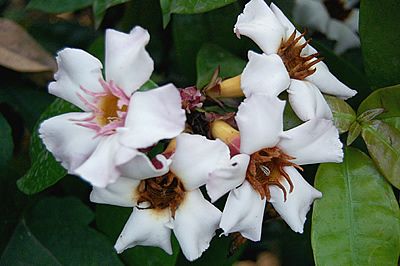The Climbing Oleander (Strophanthus gratus) is a woody, scandent, semi-deciduous, flowering, and ornamental vine, widely known for its toxic and medicinal properties. Native to various countries in West Africa, it contains substances such as ouabain, which, depending on the dose, can be a remedy for people with heart failure, or a powerful poison, used to poison the tips of arrows and spears for hunting by African peoples.
With vigorous growth, it can reach 82 feet (25 meters) in length and 6 inches (15 cm) in trunk diameter. It is branched, and the branches, ranging in color from brown to purplish, are full of lenticels. Its leaves are opposite, simple, entire, leathery, glabrous, and shaped ovate or elliptical to obovate. It blooms at the end of spring and the beginning of summer, producing inflorescences of the dichasium type (dichotomous cyme), with bell-shaped, pentamerous flowers, purple sepals, and white or pinkish petals, highly fragrant.
The fruit consists of two divergent, bivalve, ellipsoid follicles, containing numerous fusiform seeds with long filaments. They require obligatory cross-pollination to form and take a year to fully mature.

A vigorous vine with shiny foliage, ideal for covering pergolas, arbors, fences, trellises, arches, among other structures. Besides serving as a vine, Climbing Oleander can also be trained as a shrub, with formative pruning, not exceeding two or three meters in height. It can also be planted in pots and planters.
In landscaping, it is usually chosen for the exoticism of its flowers, as well as for its delicate and intense fragrance. Ideal for regions with tropical to equatorial climates. Curiosity: The seeds of the plant contain high concentrations of glycosides, which are used by the pharmaceutical industry. Thus, it becomes an export product for African countries.
It should be cultivated in full sun or partial shade, in fertile soil enriched with organic matter, well-drained, and watered regularly. It is sensitive to intense cold and appreciates tropical heat and humidity. It is advisable to train the plant on a support, in addition to formative pruning, always with the protection of gloves and long-sleeved clothing. It propagates by seeds and more commonly by cuttings rooted in the spring.

